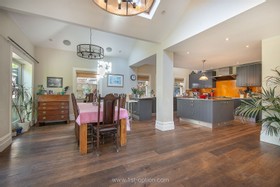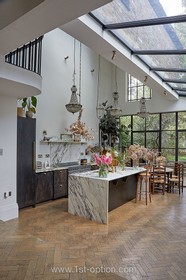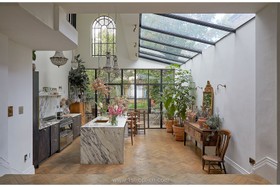Kitchen islands have become an increasingly popular feature in modern and contemporary homes. They typically match or coordinate with the materials and theme of the rest of the kitchen units, depending on the style of interior decor. They help connect various areas of the kitchen, making it a more cohesive space. They can also be highly utilised with added storage, as well as providing more space either for cooking, eating, working, studying and more.
Some kitchen islands can also be fitted with sinks and hobs, perfect for the motivated chefs of the household. They can also feature extra space, making do as a breakfast bar, creating a more social atmosphere around the island. The most common shapes for islands are square and rectangular, although modern design has seen a huge range of asymmetric and curved fittings, making this useful feature a little more playful.
When kitchen islands first began to really popularise in regular family homes around the 1990s, it is said that carpenters would use a technique when planning the shape of the island - they would look at the floor plan from above and form the fixture as the same shape as the kitchen, placed in the middle of the room. This could sometimes minimise the potential size of workspace across the island, but definitely gave some kitchens a special look. Now, contemporary homes will typically feature symmetrical islands, except for some location owners who like to stand out from the crowd. For example, our property Cuva features a phenomenal, curved kitchen island with a hollow centre to allow for a practical workspace. It is also fronted with raw wooden textile which matches with the surrounding furnishings - how unique! As kitchen units tend to be visually clean, sharp and more rectangular than other parts of the house, experimenting with different shapes and features can be another way to add some more character to the space.
History of Kitchen Islands
The first concepts of what would become the kitchen island arose around the 1800’s. This time saw traditional European homes install work tables near or in front of their stove or hearths. So, this feature technically existed long before being referred to as an island, and its evolution has made a mark in modern interior design.
Moving on, in the 1930s, American architect, writer, educator and designer - Franklin Lloyd Wright - was designing a kitchen for one of his clients. The client’s main wish for her kitchen was to create one in which she could stay ‘in touch with her guests’ as she cooked for them, highlighting the further potential of this emerging piece.
Similarly, in the 1960s, America saw culinary teacher, author and TV personality, Julia Child. Her show’s concept was working and cooking in the centre of the kitchen while simultaneously speaking with her guests. So, you can imagine how perfect a kitchen island would be in this case, acting as ‘both a workstation and a stage’. Most modern cooking shows and tutorials now use the same visual concept across videography, making use of this advantageous fixture.
The 1990s, as mentioned earlier on, saw an increase in the popularity of islands - it’s said that this was a result of the introduction of the Food Network in America, increasing the fascination with professional and home cooking for the everyday person. However, in the 2000s, the intentions of the island shifted for some, with interior design requests for appliances like dishwashers, sinks and hobs to be incorporated into the structures for maximum utility. This also meant that all cooking and cleaning could be contained to the island, leaving surrounding worktops free and clean, or open for accessories and decor.
Still today, built-in appliances are prevalent, and newer technologies such as drink coolers, wine fridges, electric hobs, ovens, microwaves and even filtered water/ hot taps are often commonplace.
Kitchen Islands at 1st Option
As islands are now a popular feature of many contemporary homes, we have a wide range of shapes, styles and textures at plenty of our amazing locations - our clients are spoilt for choice!
For some undoubtedly eye-catching compositions, we recommend taking a look at London’s First Option Studio and Jux, flaunting unique shapes across wooden exteriors. There’s also Northamptonshire’s Bloom, which presents itself with a delicate but bright pink exposed wooden worktop.
Perfect for lifestyle and cooking shoots, we would suggest our clients take a peek at The Kitchen, Kingsley, Plum, Albion or even the fantastic Curious for something more modern and clean. For marvellous islands that purposely double-up as breakfast bars, please have the pleasure of taking a look at Brighton’s Phoenix, Hertfordshire's Ridgeway, Surrey’s Rockett and the wonderful Vert in Enfield, Greater London. Celine’s kitchen island is the centre of a light and beautiful, open-plan space. It is understated, showcasing a light marble worktop and a natural wooden base with concealed storage units. The natural wood matches with other elements throughout the room, gently and cohesively blending with deep greens and lighter pastels.
To get a real sense of the elegance of this space and to view the island in real-time, head over to our video location walkthrough with the owner of Celine. The video, titled My Home My Haven, can also be viewed on YouTube. You can also have a read about it on our blog.
If you’re in need of a kitchen and island set-up for your next creative project, get in touch today and we can get the ball rolling!





























































































































































































































































































































































































































































































































































































































